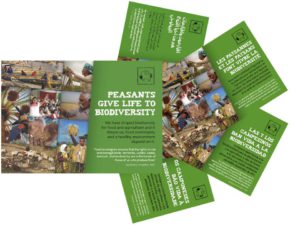January 27, 2017
PEASANTS GIVE LIFE TO BIODIVERSITY
“This brochure describes the importance to us of biodiversity for food and agriculture versus the more restricted perspective of “genetic resources”. For us biodiversity is the relationship of seeds, animals, pollinators, microorganisms, soils and water, forests, etc., and all living things, including ourselves, which ensures harmony with nature and the ancestral knowledge of cultures. The document is based on local experiences of the dynamic management of agricultural biodiversity, the threats to it, and our ways of resistance and protection. It highlights peasant participation in research and in the development of public policies in the framework of Food Sovereignty of the people.”
Antonio González, Agricultural Biodiversity Working Group of the NGO/CSO International Planning Committee for Food Sovereignty (IPC)
We have shaped biodiversity for food and agriculture and it shapes us; food sovereignty and a healthy environment depend on it.
This brochure has been produced to help raise awareness of the importance of biodiversity for food and agriculture – agricultural biodiversity – and the role that small-scale producers are playing in sustaining it.
The brochure emphasises the role that peasant producers have in sustaining agricultural biodiversity through:
- stimulating our interconnected model of production and consumption;
- connecting those who grow and harvest directly with those who eat;
- reclaiming access to our territories – land and waters;
- exerting collective control over our seeds and other components of agricultural biodiversity.
It also highlights peasant participation in research and the elaboration of public policies that can develop and defend agricultural biodiversity, in the framework of Food Sovereignty.
The brochure concludes with four commitments by peasant food providers to enhance agricultural biodiversity by:
- Strengthening and promoting the dynamic management of agricultural biodiversity by peasant food providers;
- Transforming research paradigms so that they respond to peasant priorities;
- Realising actions that guarantee the collective rights of peasants and Indigenous Peoples to seeds, livestock breeds, and other agricultural biodiversity, and to their territories, and;
- Reinforcing the interconnecting and collective rural-urban food webs and local markets, which feed the majority of people in the world.
* Copies of this brochure in Arabic, English, French, Portuguese and Spanish, are available here.
